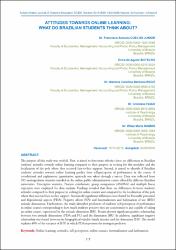Attitudes towards online learning: what do Brazilian students think about?

View/Open
Access
info:eu-repo/semantics/openAccessAttribution-NonCommercial 3.0 United Stateshttp://creativecommons.org/licenses/by-nc/3.0/us/Date
2019Author
Coelho Junior, Francisco AntonioBotelho, Erica de Aguiar
Rego, Mariana Carolina Barbosa
Faiad, Cristiane
Ramos, Wilsa Maria
Metadata
Show full item recordCitation
Coelho Junior, F. A., Botelho, E. A., Rego, M.C.B., Faiad, C., Ramos, W.M. (2019). Attitudes towards online learning: what do Brazilian students think about? TOJDE 20 (4), 117-134.Abstract
The purpose of this study was twofold. First, it aimed to determine whether there are differences in Brazilian
students’ attitudes towards online learning compared to their purpose in seeking for this modality and the
localization of the pole where they received face-to-face support. Second, it aimed to identify if Brazilian
students’ attitudes towards online learning predict their self-perception of performance in the course. A
correlational and explanatory quantitative approach was taken through a survey. Data was collected from
593 undergraduate students enrolled in the online public administration course offered by different Brazilian
universities. Descriptive statistics, Pearson correlations, group comparison (ANOVA) and multiple linear
regression were employed for data analysis. Findings revealed that there are differences between students’
attitudes compared to their purpose in seeking for online courses and compared to the localization of the pole
where they received face-to-face support. Statistically significant differences were found for Favorable personnel
and dispositional aspects (PDA), Negative affects (NA) and Internalization and habituation of use (IHU)
attitude dimensions. Furthermore, the study identified predictors of students’ self-perception of performance
in online courses corresponding to how much students perceive they are accustomed to and capable of taking
an online course, represented by the attitude dimension IHU. Results showed significant positive relationship
between two attitude dimensions (PDA and PC) and the dimension IHU. In addition, significant negative
relationship was found between the biographical variable family income and the dimension IHU. The model
explains 40% of the variance of IHU in which PDA represents the strongest predictor. The purpose of this study was twofold. First, it aimed to determine whether there are differences in Brazilian
students’ attitudes towards online learning compared to their purpose in seeking for this modality and the
localization of the pole where they received face-to-face support. Second, it aimed to identify if Brazilian
students’ attitudes towards online learning predict their self-perception of performance in the course. A
correlational and explanatory quantitative approach was taken through a survey. Data was collected from
593 undergraduate students enrolled in the online public administration course offered by different Brazilian
universities. Descriptive statistics, Pearson correlations, group comparison (ANOVA) and multiple linear
regression were employed for data analysis. Findings revealed that there are differences between students’
attitudes compared to their purpose in seeking for online courses and compared to the localization of the pole
where they received face-to-face support. Statistically significant differences were found for Favorable personnel
and dispositional aspects (PDA), Negative affects (NA) and Internalization and habituation of use (IHU)
attitude dimensions. Furthermore, the study identified predictors of students’ self-perception of performance
in online courses corresponding to how much students perceive they are accustomed to and capable of taking
an online course, represented by the attitude dimension IHU. Results showed significant positive relationship
between two attitude dimensions (PDA and PC) and the dimension IHU. In addition, significant negative
relationship was found between the biographical variable family income and the dimension IHU. The model
explains 40% of the variance of IHU in which PDA represents the strongest predictor.
Source
Turkish Online Journal of Distance Education-TOJDEVolume
20Issue
4Collections
The following license files are associated with this item:
Related items
Showing items related by title, author, creator and subject.
-
Online course design: taking a right turn!
AL-Naabi, Ishaq; Al Barwani, Thuwayba; Al-Humaidi, Salma; Neisler, Otherine (Anadolu Üniversitesi, 2021)Guided by Nation and Macalister’s (2010) eight-step language curriculum design model, a 5-week online course was designed to teach critical thinking skills for foundation students at the Arab Open University (Oman). The ... -
Exploring online learners’ perspectives in relation to proctored exams
Anadolu Üniversitesi; 0000-0002-2035-1292; 0000-0001-5083-7982; 0000-0001-9174-4299; Aydemir, Mesut; Erdogdu, Erdem; Ucar, Hasan (Anadolu Üniversitesi, 2024)This study targets to investigate the opinions and perceptions of the online and distance learners regarding to online proctored exams. A qualitative case study was employed to explore views of the participants related to ... -
German Teacher Candidates Stance to Creating Online Quizzes
Başaran, Bora (London Science Publishing LTD, 2010)The technology also the Internet is growing quickly. Today's technology is helping schools to effectively manage modern classrooms that are increasingly differentiated due to changing demographics and standards. Teacher ...


















